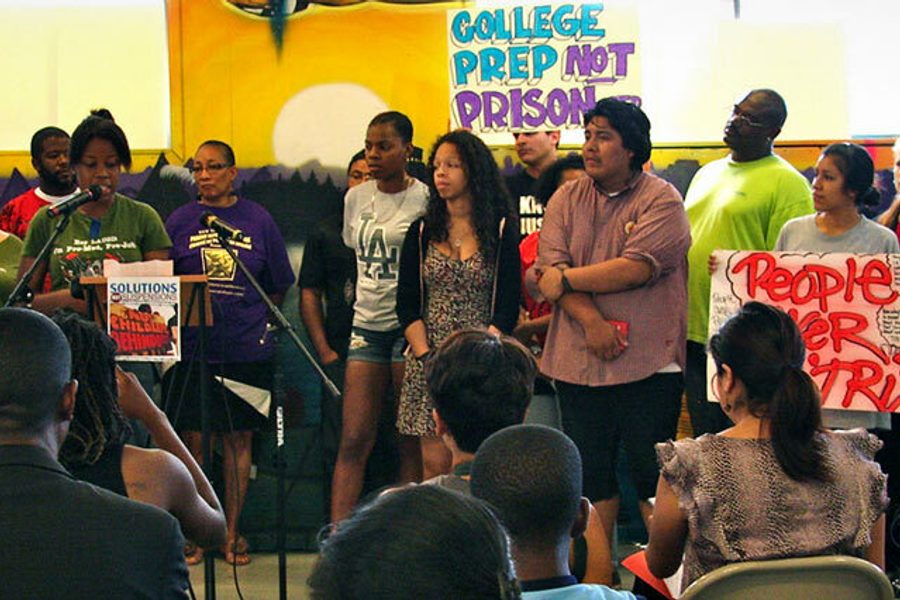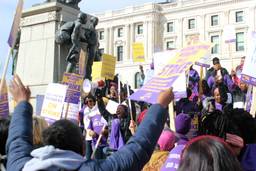Prison Prep School
‘Zero-tolerance’ and ‘tough-on-crime’ policies put students in a school-to-prison pipeline.
Rebecca Burns

Metal detectors and uniformed security guards greet students each day at Orr Academy on Chicago’s West Side. “My high school seemed like its own personal prison,” Edward Ward, a 2011 Orr graduate, told the Senate Judiciary Committee during his testimony in December 2012. He recalled how a police processing center was even set up to book students on school grounds.
Ward’s testimony was part of a historic congressional hearing on the school-to-prison pipeline. With more than 3 million students suspended or expelled each year, U.S. schools are “increasingly a gateway to the criminal justice system,” according to Sen. Richard J. Durbin (D-Ill.), who convened the hearing.
Activists warn that this trend is exacerbating the racial disparities that already permeate the prison system. A 2010 study from Indiana University found that, compared with their white peers, black male middle-school students are three times more likely to be suspended, and black female students, four times. The Senate hearing represents a landmark moment in the campaign to eliminate school disciplinary policies that organizers say criminalize students and fail to address root causes of behavioral problems.
The emergence of the school-to-prison pipeline is linked to the proliferation of zero-tolerance policies adopted throughout the nation during the 1990s, prompted in part by a series of high-profile school shootings and a media narrative fixated on youth violence. In addition to bringing students into direct contact with law enforcement through school-based arrests and referrals to juvenile courts, schools can indirectly push students into the criminal justice system through policies that may isolate and exclude struggling students, such as out-of-school suspensions and high-stakes testing.
Advocates say the issue is inseparable from the broader context of so-called tough-on-crime policies that have underpinned skyrocketing rates of incarceration among blacks and Hispanics. Despite the fact that school violence — like violent crime in general — has been in decline over the past two decades, police presence at schools has become increasingly normalized. In a 2007 nationwide survey, 69 percent of students reported that their schools had either police or security guards.
Some districts otherwise facing funding problems still employ a heavy security presence. A report by Voices of Youth in Chicago Education, a group that organizes around education issues, found that “in 2010, Chicago Public Schools spent $51.4 million on schoolbased security guards, about 15 times more than the $3.5 million it spent on college and career coaches.”
According to Judith Browne Dianis, co-director of the civil rights organization the Advancement Project, arrests are now common for a broad range of minor infractions. “Schools have redefined developmentally appropriate behaviors as crimes,” she testified at the Senate hearing. “Pushing and shoving in the schoolyard is now a battery, and talking back is now disorderly conduct.”
The result, racial justice organizers say, has been an expansion of the war on drugs into a war on the nation’s most vulnerable youth. In addition to disproportionately harsh discipline toward students of color, the IU study found that students with disabilities are statistically twice as likely to be removed from school as non-disabled students, and LGBT youth are also subject to overly punitive measures.
In a six-year study of school disciplinary policies, researchers at Texas A&M tracked disciplinary actions against 1 million Texas students, finding that that only 3 percent were for conduct requiring punishment under state law — the rest were made at the discretion of schools. The 2011 report, “Breaking Schools’ Rules,” also identified large variations in the rates of suspension and expulsion between schools with nearly identical demographics, affirming that harsh disciplinary regimes are a policy choice employed by schools rather than a reflection of the school environment. Researchers found that a majority of students in Texas were expelled or suspended at least once between grades seven and 12, with 15 percent punished this way 11 or more times.
Citing this research, the U.S. Departments of Justice and Education launched an initiative in July 2011 to curtail policies that push students out of school, collect research on effective alternatives and ensure that school practices are in accordance with federal civil rights laws. The Senate hearing concluded with a pledge from the Office of Juvenile Justice to provide new federal guidelines on school discipline policies.
Heightened federal attention comes on the heels of a series of organizing victories by coalitions of students, parents and community groups in various cities. In August 2011, students and civil rights groups in Los Angeles won a hearing with the head of the city’s juvenile court system over the truancy sweeps ostensibly intended to improve attendance. L.A. school police and the LAPD issued nearly 50,000 tickets following the policy’s launch in 2004; students testified that the $250 fines and mandatory court appearances were discouraging many from attending class. Two months later, school police issued new rules that eliminated truancy sweeps during the first 90 minutes of the school day and require officers to ask late students whether they have a valid excuses. In response to calls for increased police transparency and accountability in schools in New York City — where a school safety division is under direct control of the NYPD and constitutes the fifth-largest police force in the country — the City Council passed the Student Safety Act in 2011.
In August 2012, a coalition of student and parent advocacy groups launched Solutions Not Suspensions, a campaign for a nationwide moratorium on out-of-school suspensions. The coalition also supports increased federal funding for alternative disciplinary approaches, such as through the Restorative Justice in Schools Act, which was introduced in Congress in 2011 but not passed.
Edward Ward, now an honors student at DePaul University, notes that positive discipline approaches depend on adequate resources for public education. While Ward attended Orr Academy, students organized to have disciplinary cases referred to a peer jury. But he says these efforts were disrupted by the stream of new administrators sent to the school to make reforms — a result of the “turnaround” program now being implemented nationwide. With each new administrator, Ward told In These Times, students had to “start over” and learn a brand new set of rules.
“When they come in, the first thing they want to focus on is how to make the school look good, ” he says. “And when that happens, the real needs of the students get neglected.”
Rebecca Burns is In These Times’ housing editor and an award-winning investigative reporter. Her work has appeared in Business Insider, the Chicago Reader, the Intercept, ProPublica Illinois and other outlets.









